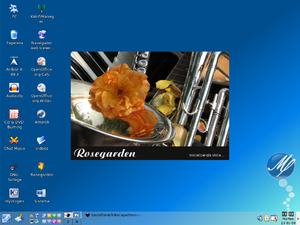Musix GNU+Linux
 | |
 Musix 1.0 R4 DVD. | |
| OS family | Unix-like |
|---|---|
| Working state | Discontinued |
| Source model | Free Software |
| Initial release | December 9, 2008 |
| Latest release | 3.0.1 / March 13, 2014 |
| Platforms | IA-32 |
| Kernel type | Monolithic (Linux-libre) |
| Userland | GNU |
| Default user interface | IceWM (previously KDE) |
| License | Exclusively free licenses per GNU Free System Distribution Guidelines (GNU FSDG)[1] |
| Official website | musixdistro |
Musix GNU+Linux is a discontinued live CD and DVD Linux distribution for the IA-32 processor family based on Debian. It contained a collection of software for audio production, graphic design, video editing and general purpose applications. The initiator and co-director of the project was Marcos Germán Guglielmetti.[citation needed]
Musix GNU+Linux was one of the few Linux distributions recognized by the Free Software Foundation as being composed completely of free software.[2]
Musix was developed by a team from Argentina, Spain, Mexico and Brazil.[citation needed] The main language used in development discussion and documentation was Spanish; however, Musix had a community of users who speak Spanish, Portuguese, and English.[citation needed]
Software[]
Musix 1.0[]
The Musix 0.x and 1.0 Rx versions were released between 2005 and 2008, with Musix 1.0 R6 being the last stable release on DVD and Musix 1.0 R2R5 the last stable release on CD.[citation needed]
The Live CD system had 1350 software packages. The Live DVD had 2279 software packages.[citation needed]
Some of the programs included: Rosegarden and Ardour, both for musicians; Inkscape for vectorial design; GIMP for manipulation of images; Cinelerra for video editing and Blender for 3D animation.[citation needed]
Its desktop was very light (only 18 MB of RAM with X.org), based on IceWM/ROX-Filer and it had a unique feature: multiple "pinboards" ordered by General Purpose apps, Help, Office, Root/Admin, MIDI, Internet, Graphics, and Audio. The pinboards are arrays of desktop backgrounds and icons.[citation needed]
A small version of the KDE desktop was included by default on the Live-CD version. The Live-DVD has a full KDE version, supporting several languages.[citation needed]
Musix 2.0[]
Musix 2.0 was developed using the live-helper scripts from the Debian-Live project. The first Alpha version of Musix 2.0[3] was released on 25 March 2009 including two realtime-patched Linux-Libre kernels.
On 17 May 2009 the first beta version of Musix 2.0 was released.[4]
The final Musix GNU+Linux 2.0 version on CD, DVD and USB was released in November 2009 by Daniel Vidal, Suso Comesaña, Carlos Sanchiavedraz, Joseangon and other Musix developers.[citation needed] This version was presented at the "Palau Firal de Congressos de Tarragona, España" by Suso Comesaña.[citation needed]
A similar LINUX-version, developed by Brazilian music teacher Gilberto André Borges, was named "Adriane" or "MusixBr". This version was not a fork and was derived from Knoppix 6.1 Adriane.[citation needed]
See also[]
- Comparison of Linux distributions
- dyne:bolic – another free distribution for multimedia enthusiasts
- GNU/Linux naming controversy
- List of Linux distributions based on Debian
References[]
External links[]
| Wikimedia Commons has media related to Musix. |
- Debian-based distributions
- Free audio software
- Operating system distributions bootable from read-only media
- Knoppix
- Linux media creation distributions
- Free software only Linux distributions
- 2008 software
- Linux distributions